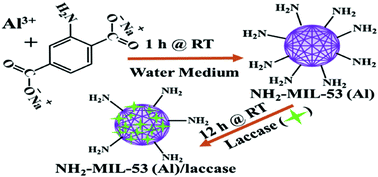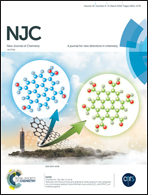One-pot synthesis of microporous nanoscale metal organic frameworks conjugated with laccase as a promising biocatalyst†
Abstract
Enzymes immobilized into or onto a smart material have attracted much attention due to their numerous applications as biocatalysts. Recently, microporous metal organic frameworks (MOFs) have been used as active supports for enzyme immobilization owing to their high surface area, high porosity, and tunable functionality. However, challenges remain in the development of MOFs for enzyme immobilization regarding (i) green synthesis approaches, (ii) high loading and activity efficiency, (iii) facile immobilization processes, and (iv) obtaining stable enzyme activity. In this study, we have developed amine-functionalized nanoscale metal organic framework (NMOF) NH2-MIL-53(Al) as a support for enzyme immobilization using green synthesis in a one-pot procedure. Herein, laccase is immobilized into the NMOFs, which possess highest stability and activity at pH 4–6, using a coprecipitation method. As most reported MOFs are unstable under slightly acidic conditions, developing MOFs that are stable at low pH is challenging. After successful immobilization, it is observed that 625 mg laccase is immobilized per 1 g of NMOF. Importantly, the immobilized enzyme showed good reusability, retaining 63% of its initial activity after being reused 10 times. Our study highlights the development of NMOFs that contain more laccase and retain stability and activity.



 Please wait while we load your content...
Please wait while we load your content...